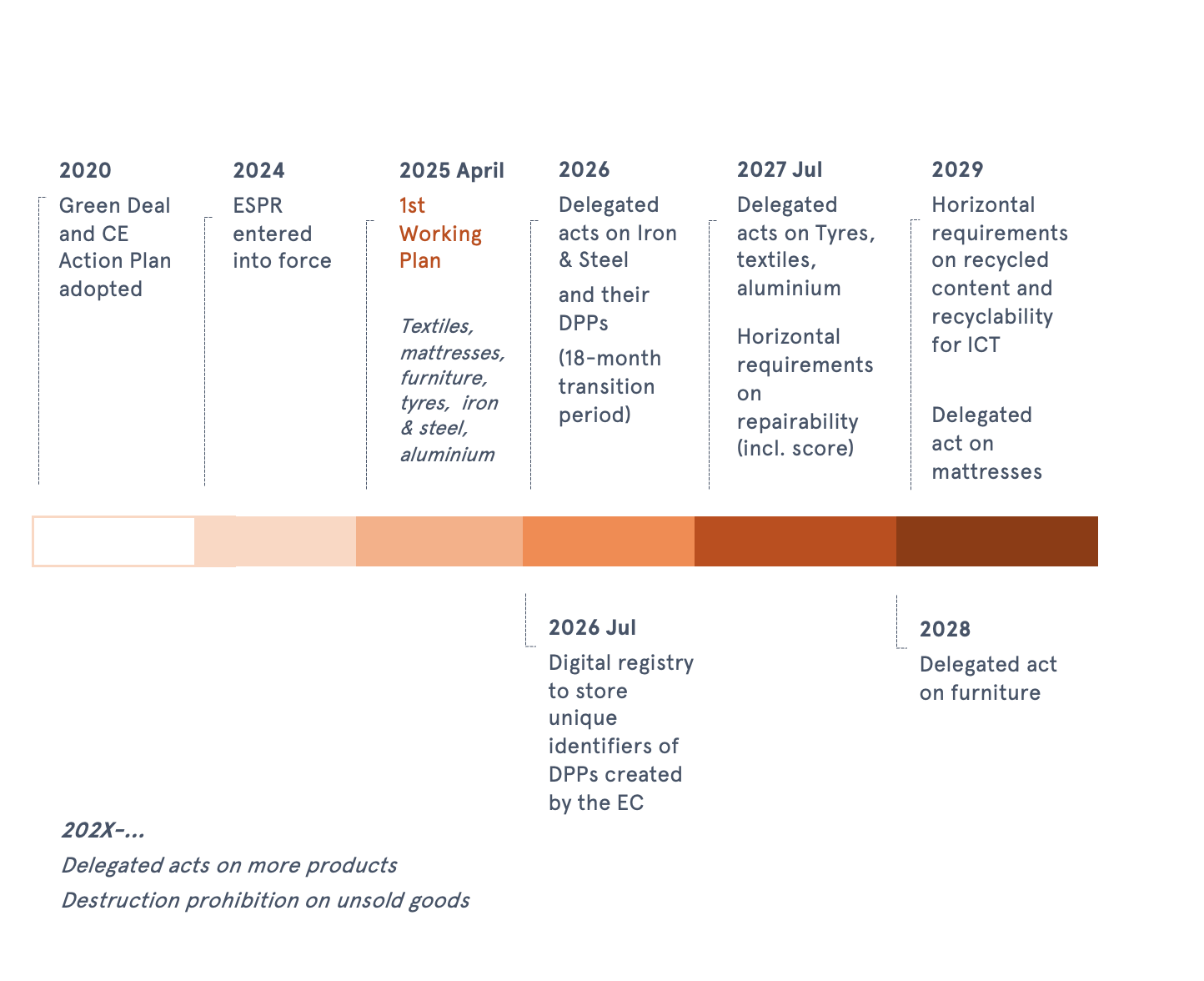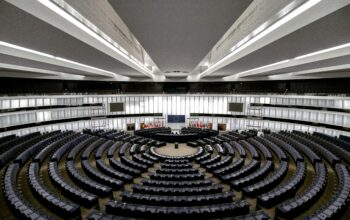
Most of a product’s impact is decided before it’s even made. From materials and energy use to repairability and recyclability, design-stage decisions shape both the environmental footprint and manufacturing costs.
In fact, 80% of a product’s carbon footprint can be traced back to choices made at the design table (EMF, 2022). This is why the EU has introduced the Ecodesign for Sustainable Products Regulation (ESPR), a major policy shift that will impact nearly all products placed on the EU market. The regulation, in force since 2024 and rolling out gradually from 2026, will set new standards for how products are designed, manufactured, and marketed.
With the first working plan (WP) for 2025-2030 now released, this article takes the ESPR and breaks it down, tackling the regulation one piece at a time. From timelines and product scope to digital product passports and enforcement, this article guides you through how companies can stay ahead on sustainable design and data requirements.
ESPR is a key part of the EU’s circular economy and climate efforts

About half of total greenhouse gas emissions and more than 90% of biodiversity loss and water stress come from resource extraction and processing of materials, fuels and food The European Green Deal (COM(2019) 640)
The ESPR is a central pillar in the EU’s broader circular economy agenda, aiming to reduce the climate- and environmental footprint of products placed on the EU market. Introduced under the EU’s Circular Economy Action Plan (CEAP), the ESPR forms the regulatory backbone of the EU’s strategy for sustainable products.
While the ESPR provides the Commission with a number of provisions, it’s the Working Plan that defines what will be in scope the next few years. The first WP, released in April 2025, outlines which products will be targeted first.
Under the 2025-2030 WP, the Commission will introduce design and information requirements for the following products and intermediate goods:

The WP also sets horizontal measures that apply across multiple product groups. The first two priorities are:
- Repairability (2027)
- Recycled content and recyclability of electrical and electronic equipment (2029)
In the future, energy-related products will also fall under the ESPR, replacing the current Ecodesign Directive.
The ESPR’s main requirements for companies
As the ESPR is a comprehensive piece of legislation, we focus on the provisions most relevant for companies. While the full timeline for product-specific requirements is still to be defined, preparatory work is already underway, starting with sectors like textiles and steel.

Performance and information requirements
Ecodesign requirements will be introduced through delegated acts, tailored to each product group. This means that the specific requirements will differ depending on the product’s characteristics.
Each delegated act will include two types of requirements:
- Performance requirements (§6) such as minimum recycled content
- Information requirements (§7) such as key features or carbon footprint
The goal is to improve the following aspects (where those are relevant to the specific product group):
When product groups share common characteristics, the EU can set horizontal ecodesign requirements. These rules apply across multiple product groups and make it easier to improve performance or sustainability using shared design or information requirements.
Introducing the Digital Product Passport
Access to the EU market will depend on one thing: credible data. Companies must be able to demonstrate compliance and disclose credible sustainability and life cycle data through the Digital Product Passport (DPP).
The DPP is essentially a digital ID card for a product –a digital file connected to the product via a QR code or serial number.
Each passport will include information on…
- Materials and origin
- Environmental impact
- How to repair, reuse or recycle the product
The specific information to be collected and made available will be defined in product-specific delegated acts under the ESPR, and possibly under other legislation where applicable (WP 3.2.).
The Digital Product Passport serves three main objectives:
- Ensure actors along the value chain can easily access and understand relevant product information
- Support national authorities in verifying product compliance
- Improve traceability along the value chain, hence also supporting supply chain due diligence
The product information must be machine-readable and follow standards of the CSRD and CSDDD. This allows everyone from manufacturers and retailers to public authorities to access and use the data.
For online sales, a digital version of the DPP must be provided, along with a backup hosted by a certified provider. The passport must remain accessible for the product’s entire lifespan and be compatible with other systems.
The requirements will therefore demand businesses to handle extensive amount of data. Hence, it is key to have a sufficient data management system in place – as well as starting the data-dialogue with suppliers early on.
To support this, the European Commission will:
- Set up a central registry to store product identifiers
- Ensure proper customs checks and market monitoring
- Launch standardisation efforts to set rules on data carriers, infrastructure and data interoperability
This rollout will happen in stages. The passport system and IT infrastructure are expected to be finalised between 2026-2027 with mandatory passports required from 2027, starting with high-impact product groups.
Ban on destruction on unsold consumer products
While not yet in force, the ESPR opens the door for a ban on destroying unsold goods, beginning with apparel and footwear. Although this measure was not included in the first WP, it may be introduced in future updates to cover other products (Annex 3).
For this first ESPR working plan, the Commission does not intend to use this provision. It is premature because the insights gained from implementing the mandatory disclosure of information on the destruction of unsold consumer products (that will provide the basis for any bans in future working plans) are not yet available ESPR Working Plan 4.2.
If this provision is included, it will force large companies to manage overproduction and ensure that their products can be repurposed or recycled if unsold. Landfilling or incineration would no longer be an option to manage stocks and protect brand value.
As of this year, large companies destroying unsold consumer products are obliged to disclose the following information on their website:
- Amount and weight of destroyed products
- Reason for destroying products
- Measures taken to prevent destruction of products
Mandatory green criteria in public procurement
Under the ESPR, public authorities across the EU must prioritise environmentally sustainable products in their purchasing decisions.
For companies supplying the public sector, this means products will need to:
- Meet minimum sustainability requirements
- Provide proof of compliance, often via Digital Product Passports
- Compete increasingly on sustainability performance, not just price
Public authorities in the EU spend over €2 trillion a year, roughly 14% of EU GDP, on goods and services. By setting these binding criteria, the EU aims to leverage public sector spending to drive demand for greener products.
A few extra notes worth knowing about the ESPR
What’s excluded from the ESPR?
A few product groups are excluded from the scope of the regulation: Food, feed, medical products, veterinary medical products, plants, animals, micro-organisms, products of human origin, vehicles (Art 13) or national defence or security products (Art 19).
What does the ESPR mean for SMEs?
To reduce the burden on small and medium-sized enterprises (SMEs), the EU will provide support in the form of tailored implementation guidelines and financial support to SMEs where needed. Support to micro-enterprises will be prioritized (Art 56).
How does the ESPR ensure compliance?
The ESPR gives national authorities more power to check that companies follow the new ecodesign rules and if not, they can face fines or have products removed from the market.
Early adoption of ecodesign has more benefits than just compliance
Companies that integrate sustainability into product design and their business models can unlock several competitive advantages:
Here’s how:
Cost savings: Using recycled or reused materials, designing for durability, and enabling repair or reuse can reduce both production and lifecycle costs. Reducing carbon emissions also entails lower carbon taxation, which rates will increase over time.
Supply chain resilience: Designing out dependency on scarce or high-risk materials reduces exposure to price volatility and regulatory restrictions.
Customer value: Consumers and B2B buyers increasingly favour sustainable products. Ecodesign can strengthen brand loyalty and open up new markets.
Innovation and growth: Circular business models, like product-as-a-service or take-back schemes, can unlock new revenue streams. But such business models are more viable when products are designed with durability, repairability, and reuse in mind. A recent McKinsey study found ecodesign and carbon savings more effective at driving innovation than mere cost savings (even though cost savings are still an outcome).
Easier access to capital: Investors and financial institutions are favoring businesses that can demonstrate credible decarbonisation and ESG strategies — where product design plays a key role.
Check out large brands like Philips, Unilever, Renault, and Nike to see how large manufacturers are working with ecodesign and circularity at scale. Or watch our webinar with Danfoss and Grundfoss who share how they are integrating ecodesign in practice.
Making a massive regulation manageable
Designing more sustainable products isn’t something you solve overnight, but it’s doable if you tackle it step by step. In this article, we’ve broken down what the ESPR means for companies, to help you move forward without getting overwhelmed.
Get in touch with our Climate Lead Ole to learn more on how Nordic Sustainability can support your team with product impact assessments and design strategies. We offer tailored support that turns ambition into action.
References
Resources
- Webinar: The EU’s proposed Ecodesign for Sustainable Products Regulation (ESPR) with Philips and the European Environmental Bureau
- Webinar: EU Policy Briefing: Circular Economy and Products
- Webinar: Achieving Climate Targets with Circularity
- Seven lessons from integrating circularity into product development


